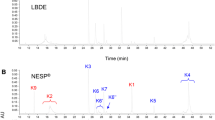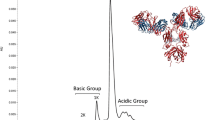Abstract
In this study, analytical profiling of the bevacizumab (BVZ) biosimilars (N = 3) approved in India were evaluated for charge heterogeneity, isoelectric focusing, aggregation and in vitro potency analysis. The charge variants were characterized using high performance cation-exchange chromatography (CEX-HPLC), capillary zone electrophoresis (CZE) and capillary isoelectric focusing (cIEF). cIEF was also used for estimation of isoelectric point (pI value). In addition, aggregate analysis was done using size exclusion high performance chromatography (SEC-HPLC). The cell-based inhibition of proliferation assay using HUVEC cells, indirect ELISA and Western blot were performed for in vitro biological activity. In addition of cell-based cytotoxicity assay was also performed and found no cytotoxic effect on both HuT78 and WIL2S cells by bevacizumab biosimilars. The significant variations in acidic (p < 0.0001) and basic variants (p < 0.0001), pI value (p = 0.0035), aggregates (p = 0.0306) of biosimilars were found as compared to innovator product; however, cell-based potency analysis (p = 0.6047) and indirect ELISA (p = 0.1611) have shown no significant difference in the biological activity. The banding patterns of all biosimilars in western blot were found similar to the innovator product. The comparatively higher basic variants in the biosimilars were attributing to the high pI value of biosimilars to that of innovator product, although these variations were not affecting the biological activity of the biosimiars. This is a unique study, wherein the independent analysis by a National Control Laboratory (NCL) will not only help the National Regulatory Authority (NRA) to assess the quality and consistency in manufacturing of BVZ biosimilars marketed in India but also facilitate the uptake of BVZ biosimilars, and sustainable access to new medicines against the anti-angiogenic therapy.








Similar content being viewed by others
References
Cristina M, Pranchevicius S, Vieira TR (2013) Production of recombinant immunotherapeutics for anticancer treatment: The role of bioengineering. Bioengineered 4:305–312
Du Yi, Walsh A, Ehrick R, Xu W, May K, Liu H (2012) Chromatographic analysis of the acidic and basic species of recombinant monoclonal antibodies. MAbs 4:578–585
Echko MM, Dozier SK (2010) Recombinant antibody technology for the production of antibodies without the use of animals People for the Ethical Treatment of Animals (PETA). AltTox.org, September 15
Ecker DM, Jones SD, Levine HL (2015) The therapeutic monoclonal antibody market. MAbs 7:9–14
Ferrara N, Henzel WJ (1989) Pituitary follicular cells secrete a novel heparin-binding growth factor specific for vascular endothelial cells. Biochem Biophys Res Commun 425:540–547
He Y, Lacher NA, Hou W, Wang Q, Isele C, Starkey J, Ruesch M (2010) Analysis of identity, charge variants, and disulfide isomers of monoclonal antibodies with capillary zone electrophoresis in an uncoated capillary column. Anal Chem 82:3222–3230
Hong G, Bazin-Redureau MI, Scherrmann JM (1999) Pharmacokinetics and organ distribution of cationized colchicine-specific IgG and Fab fragments in rat. J Pharm Sci 88:147–153
Joshi S, Rathore AS (2020) Assessment of structural and functional comparability of biosimilar products: trastuzumab as a case study. BioDrugs 34:209–223
Khawli LA, Goswami S, Hutchinson R, Kwong ZW, Yan J et al (2010) Charge variants in IgG1: Isolation, characterization, in vitro binding properties and pharmacokinetics in rats. Mabs 2:613–624
Lai Y, Wang R, Chen X, Tang D, Hu Y, Cai J, Zhang Q, Hu H (2010) Emerging trends and new developments in monoclonal antibodies: a scientometric analysis (1980–2016). Hum Vaccin Immunother 13:1388–1397
Liu Z, Valente J, Lin S, Chennamsetty N, Qiu D, Bolgar M (2019) Cyclization of N-terminal glutamic acid to pyro-glutamic acid impacts monoclonal antibody charge heterogeneity despite its appearance as a neutral transformation. J Pharm Sci 108:3194–3200
Lu RM, Hwang YC, Hwang I, Liu J, Lee CC, Tsai HZ, Li HJ, Han-Chung D (2020) Development of therapeutic antibodies for the treatment of diseases. J Biomed Sci 27:1
Moritz B, Locatelli V, Niess M, Bathke A, Kiessig S, Entler B et al (2017) Optimization of capillary zone electrophoresis for charge heterogeneity testing of biopharmaceuticals using enhanced method development principles. Electrophoresis 38:3136–3146
Penn JS, Madan A, Caldwell RB, Bartoli M, Caldwell RW, Hartnett ME (2008) Vascular endothelial growth factor in eye disease. Prog Retin Eye Res 27:331–371
Putnam WS, Prabhu S, Zheng Y, Subramanyam M, Wang Y-MC (2010) Pharmacokinetic, pharmacodynamic and immunogenicity comparability assessment strategies for monoclonal antibodies. Trends Biotechnol 28:509–516
Ratanji KD, Derrick JP, Dearman RJ, Kimber I (2014) Immunogenicity of therapeutic proteins: influence of aggregation. J Immunotoxicol 11:99–109
Rodwell JD, Alvarez VL, Lee C, Lopes AD, Goers JW, King HD et al (1986) Site-specific covalent modification of monoclonal antibodies: in vitro and in vivo evaluations. Proc Natl Acad Sci USA 83:26326
Singh SK, Narula G, Rathore AS (2016) Should charge variants of monoclonal antibody therapeutics be considered critical quality attributes? Electrophoresis 37(17–18):2338–2346
Singh S, Kumar NK, Dwiwedi P, Charan J, Kaur R, Sidhu P, Chugh VK (2018) Monoclonal antibodies: a review. Curr Clin Pharmacol 13:85–99
USP 39 NF 34 <129> (2016) Analytical Procedures for Recombinant Therapeutic Monoclonal Antibodies/Biological Tests
Verheul HM, Hoekman K, Luykx-de BS, Eekman CA, Folman CC, Broxterman HJ, Pinedo HM (1997) Platelet: transporter of vascular endothelial growth factor. Clin Cancer Res 3:2187–2190
Visser J, Feuerstein I, Stangler T, Schmiederer T, Fritsch C, Schiestl M (2013) Physicochemical and functional comparability between the proposed biosimilar rituximab GP2013 and originator rituximab. BioDrugs 27:495–507
Wang Y, Fei D, Vanderlaan M, Song A (2004) Biological activity of bevacizumab, a humanized anti-VEGF antibody in vitro. Angiogenesis 7:335–345
Weitzhandler M, Farnan D, Horvath J, Rohrer JS, Slingsby RW, Avdalovic N, Pohl C (1998) Protein variant separations by cation-exchange chromatography on tentacle-type polymeric stationary phases. J Chromatogr A 828:365–372
Witmer AN, Vrensen GFJM, Van Noorden CJF, Schlingemann RO (2003) Vascular endothelial growth factors and angiogenesis in eye disease. Prog Retinal Eye Res 22:1–29
Zhao YY, Wang N, Liu WH, Tao WJ, Liu LL, Shen ZD (2016) Charge variants of an avastin biosimilar isolation, characterization, in vitro properties and pharmacokinetics in rat. PLoS ONE 11:e0151874
Acknowledgements
Our study team is thankful to CDSCO for providing the bevacizumab samples for quality evaluation. Study was fully funded by National Institute of Biologicals (Ministry of Health and Family Welfare), (Grant no. NIB-TAL) Government of India.
Author information
Authors and Affiliations
Corresponding author
Ethics declarations
Conflict of interest
There is no conflict of interest.
Rights and permissions
About this article
Cite this article
Prakash, A., Mishra, N.N., Vaish, U. et al. Comparative analytical profiling of bevacizumab biosimilars marketed in India: a national control laboratory study. 3 Biotech 10, 516 (2020). https://doi.org/10.1007/s13205-020-02506-9
Received:
Accepted:
Published:
DOI: https://doi.org/10.1007/s13205-020-02506-9




